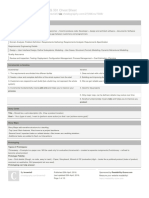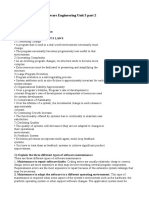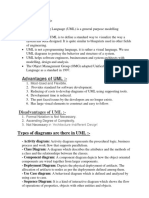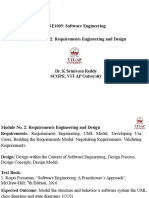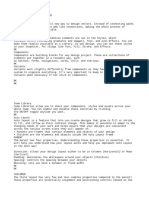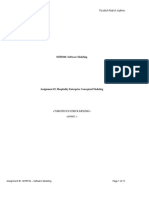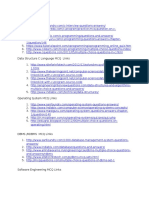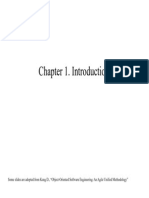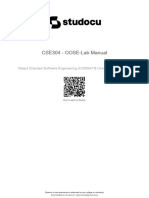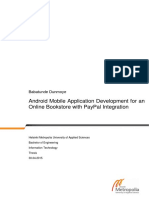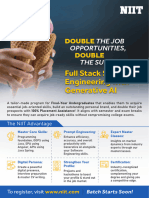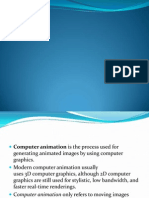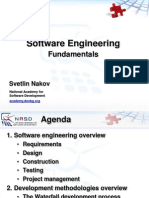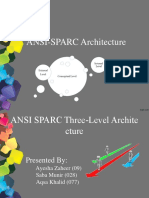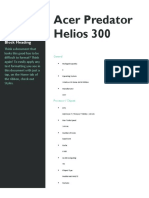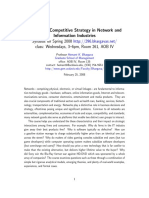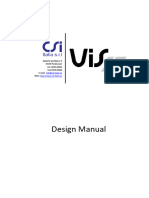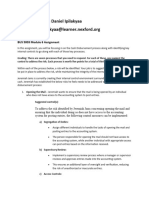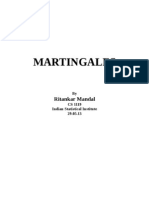Practical Software Engineering Fundamentals
Software Development Practices and Methodologies
Svetlin Nakov
Telerik Corporation
www.telerik.com
�Table of Contents
Software engineering overview
Requirements
Design
Construction Testing Project management
Development methodologies overview
The waterfall development process
Heavyweight methodologies Agile methodologies, SCRUM and XP
�Software Engineering
Requirements, Design, Construction, Testing
�What is Software Engineering?
Software engineering is the application of a systematic, disciplined, quantifiable approach to the development, operation, and maintenance of software
Definition by IEEE
�Software Engineering
Software engineering is:
An engineering discipline that provides knowledge, tools, and methods for:
Defining software requirements
Performing software design
Software construction Software testing Software maintenance tasks Software project management
�Software Development Activities
Software development always
includes the following activities (to some extent):
Requirements analysis Design Software Project Management
Construction
Testing (sometimes)
These activities
do not follow strictly one after another (depends on the methodology)!
Often overlap and interact
�Software Requirements
Functional, Non-functional Requirements, SRS
�Software Requirements
Software requirements define the
functionality of the system
Answer the question "what?", not "how?" Define constraints on the system
Two kinds of requirements
Functional requirements
Non-functional requirements
�Requirements Analysis
Requirements analysis
starts from a vision
about the system
Customers don't know what they need! Requirements come roughly and are specified and extended iteratively
Prototyping
is often used, especially for the user interface Specification (SRS)
The outcome is the Software Requirements
�Software Requirements Specification (SRS)
The Software Requirements Specification
(SRS) is a formal requirements document
It describes in details:
Functional requirements
Business processes Actors and use-cases
Non-functional requirements
E.g. performance, scalability, constraints, etc.
�Software Requirements
It is always
hard to describe and document the requirements in comprehensive way
Good requirements save time and money
Requirements always
change during the
project!
Good software requirements specification reduces the changes Prototypes significantly reduce changes Agile methodologies are flexible to changes
�Software Requirements Specifications (SRS) and UI Prototypes
Live Demo
�Software Architecture and Software Design
�Software Architecture and Software Design
Software design is a technical description
(blueprints) about how the system will implement the requirements
The system architecture
describes:
How the system will be decomposed into subsystems (modules)
Responsibilities of each module
Interaction between the modules Platforms and technologies
�System Architecture Diagram Example
�Software Architecture Diagram Example
16
�Software Design
Detailed Design
Describes the internal module structure
Interfaces, data design, process design
Object-Oriented Design
Describes the classes, their responsibilities, relationships, dependencies, and interactions
Internal Class
Design
Methods, responsibilities, algorithms and interactions between them
�Software Design Document (SDD)
The Software Design Document (SDD)
Formal description of the architecture and design of the system
It contains:
Architectural design
Modules and their interaction (diagram)
For each module
Process design (diagrams)
Data design (E/R diagram) Interfaces design (class diagram)
�Software Design Document
Live Demo
�Software Construction
Implementation, Unit Testing, Debugging, Integration
�Software Construction
During the software construction
phase
developers create the software
Sometimes called implementation phase
It includes:
Internal method design
Writing the source code Writing unit tests (sometimes) Testing and debugging Integration
�Writing the Code
Coding is the process of writing
the programming code (the source code)
The code strictly follows the design Developers perform internal method design as part of coding
The source code is the output of the software
construction process
Written by developers
Can include unit tests
�Testing the Code
Testing checks whether the developed
software conforms to the requirements
Aims to identify defects (bugs)
Developers test the code after writing
it
At least run it to see the results
Unit testing is even better
Units tests can be repeated many times
System testing is done by QA engineers
Unit testing is done by developers
�Debugging
Debugging aims to find the source of already
identified defect and to fix it
Performed by developers
Steps in debugging:
Find the defect in the code
Identify the source of the problem Identify the exact place in the code causing it
Fix the defect Test to check if the fix is working correctly
�Integration
Integration is putting all
pieces together
Compile, run and deploy the modules as single system Test to identify defects
Integration strategies
Big bang, top-down and bottom-up Continuous integration
�Coding != Software Engineering
Inexperienced developers consider coding the
core of development
In most projects coding is only 20% of the project activities!
The important decisions are taken during the requirements analysis and design Documentation, testing, integration, maintenance, etc. are often disparaged
Software engineering is not just coding!
Programmer != software engineer
�Software Verification and Testing
�Software Verification
What is
software verification?
It checks whether the developed software conforms to the requirements Performed by the Software Quality Assurance Engineers (QA engineers)
Two approaches:
Formal reviews and inspections
Different kinds of testing
Cannot certify absence of defects!
Can only decrease their rates
�Software Testing
Testing checks whether the developed
software conforms to the requirements
Testing aims to find defects (bugs)
Black-box and white-box tests
Unit tests, integration tests, system tests, acceptance tests
Stress tests, load tests, regression tests Tester engineers can use automated test tools to record and execute tests
�Software Testing Process
Test planning
Establish test strategy and test plan During requirements and design phases
Test development
Test procedures, test scenarios, test cases, test scripts
Test execution Test reporting Retesting the defects
�Test Plan and Test Cases
The test plan
is a formal document that describes how tests will be performed
List of test activities to be performed to ensure meeting the requirements
Features to be tested, testing approach, schedule, acceptance criteria
Test scenarios
and test cases
Test scenarios stories to be tested
Test cases tests of single function
�Test Plans and Test Cases
Live Demo
�Software Project Management
�What is Project Management?
Project management is the discipline
of organizing and managing work and resources in order to successfully complete a project means within defined scope, quality, time and cost constraints
Scope
Successfully
Project constraints:
Quality
�What is Software Project Management?
Software project management
Management discipline about planning, monitoring and controlling software projects
Project planning
Identify the scope, estimate the work involved, and create a project schedule
Project monitoring and control
Keep the team up to date on the project's progress and handle problems
�What is Project Plan?
The project plan
is a document that describes how the work on the project will be organized
Contains tasks, resources, schedule, milestones, etc.
Tasks have start, end, assigned resources (team members), % complete, dependencies, nested tasks, cost, etc.
Project management tools
simplify creating and monitoring project plans
�Project Plan Example
�Development Methodologies
Waterfall, Extreme Programming, Scrum
�What is a Development Methodology?
A development methodology is a set of
practices and procedures for organizing the software development process
A set of rules that developers have to follow A set of conventions the organization decides to follow
A systematical, engineering approach for organizing and managing software projects
�Development Methodologies
The "Waterfall" Process
Old-fashioned, not used today
Rational Unified Process
(RUP)
Very formal, lots of documentation
Microsoft Solutions Framework (MSF)
Formal heavyweight approach
Agile Development Processes
E.g. Extreme Programming (XP), SCRUM, etc.
�The Waterfall Development Process
�The Waterfall Process
The waterfall development process:
Software Requirements
Software Design Implementation (Coding)
Verification (Testing)
Operation (Maintenance)
�Formal Methodologies
Formal methodologies are heavyweight!
System Requirements Requirements Design
Software Requirements Software Requirements Specification Preliminary Design Document Preliminary Design Prelim. Review
Analysis Detailed Design Coding
Set of documents, diagrams, etc.
Analysis Program Design Design Review Final Design Code Review
Integration Testing Usage Coding Operating Instructions Testing
UI Design Document
Test Plan
Operations
�Agile Development
�The Agile Manifesto
Our highest priority is to satisfy the customer through early and continuous delivery of valuable software
Manifesto for Agile
�The Agile Spirit
Incremental
Working software over comprehensive documentation
Cooperation
Customer collaboration over contract negotiation
Straightforward
Individuals and interactions over processes and tools
Adaptive
Responding to change over following a plan
�Agile Methodologies
eXtreme Programming (XP)
Scrum
Feature-Driven Development (FDD) Crystal family of methodologies Adaptive Software Development (ASD) Dynamic System Development Model (DSDM)
Agile Unified Process (AUP)
�Extreme Programming: The 12 Key Practices
The Planning Game Small Releases Metaphor Simple Design Test-Driven Development Refactoring Pair Programming Collective Ownership Continuous Integration 40-Hour Workweek On-site Customer Coding Standards
�Scrum
Scrum is an iterative incremental framework
for managing complex projects
Scrum roles:
Scrum Master maintains the Scrum processes
Product Owner represents the stakeholders
Team a group of about 7 people
The team does the actual development: analysis, design, implementation, testing, etc.
49
�Scrum Terminology
Sprint
An iteration in the Scrum development Usually few weeks
Product Backlog
All features that have to be developed
Sprint
Backlog
All features planned for the current sprint
50
�The Scrum Process Framework
51
�Scrum Practices
Sprint
Planning Meeting
At the beginning of the sprint cycle Establish the Sprint backlog
Daily Scrum stand-up
meeting
Each day during the sprint project status from each team member
Timeboxed to 15 minutes
Sprint
Review Meeting
52
Review the work completed / not completed
�Software Engineering Fundamentals
Questions?
http://academy.telerik.com



